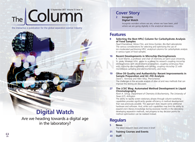Investigating the Effectiveness of Caviar in Cosmetic Skin Creams
Researchers from the University of Torino have developed a novel HPLC–HRMS application for evaluating cosmetic ingredient composition. The application was used to analyze and compare sturgeon eggs, commonly known as caviar, and brill eggs, and their use in beauty creams as lipid sources.
Photo Credit: Leon Rafael/Shutterstock.com

Researchers from the University of Torino, Italy, have developed a novel high performance liquid chromatography coupled to high resolution mass spectrometry (HPLC–HRMS) application for evaluating cosmetic ingredient composition. The application was used to analyze and compare sturgeon eggs, commonly known as caviar, and brill eggs, and their use in beauty creams as lipid sources (1).
Lipids are regularly used in cosmetics because of their positive attributes, particularly with regards to skin creams. These characteristics make lipids particularly useful as emollients and moisturizers, but they are also known to have antioxidant and antibacterial abilities as well as acting as a penetration enhancer. There are three primary lipid sources used in cosmetics: vegetables, such as almond, apricots, olives, and safflower oils, are heavily utilized, while bacteria have been developed which can synthesize fatty acids (FAs); animals are also a source with beeswax, lanolin, and fish oil common sources. In recent years, products using caviar have appeared on the cosmetic market. Caviar is highly coveted as a food stuff; its unique reputation as a luxury of the wealthy places it in the same category as truffles and kobe beef. Consequently, cosmetics produced from it are very expensive. For this reason, researchers investigated brill eggs as a possible alternative because of the latter being considerably cheaper, and its huge availability, as reported in recent marine datasets (2).
Researchers used gas chromatography (GC)–MS to analyze fatty acids methyl esters (FAMEs) and HPLC–HRMS to analyze triacylglycerol (TAG) in both sturgeon and brill eggs. Results indicated that caviar contained approximately eight times as many TAGs as in brill eggs, as well as a wider variety of TAG species. In particular, the results indicated much lower levels of linoleic acid, which is well documented to influence the metabolic process of the skin (3–6). Caviar was also shown to contain higher concentrations of omega-3 FAs and linolenic and oleic acids.
These results validate the use of caviar as an effective component in cosmetics, eliminating brill eggs as a cheaper alternative because of the inferior levels of well documented beneficial lipids, such as linoleic acid.
References
- F. Dal Bello et al., Eur. J. Lipid. Sci. Technol. 118, (2016).
- International Council for the Exploration of the Sea (ICES) marine dataset, www.ices.dk
- A.M. Rabasco Alvarez and M.L Gonzalez Rodrıgues, Grasas Aceites 51, 74–96 (2000).
- T. Kristmundsdottir and S. Skulason, in Lipids and Essential Oils as Antimicrobial Agents, H. Thormar, Ed. (John Wiley and Sons, Ltd, 2011), pp. 152–177.
- K. Mahmood, in Lipids and Skin Health, A. Pappas, Ed. (Springer Science, 2014), pp. 321–328.
- E. Niki, Free Radical Res. 49, 827–834 (2015).

Characterizing Plant Polysaccharides Using Size-Exclusion Chromatography
April 4th 2025With green chemistry becoming more standardized, Leena Pitkänen of Aalto University analyzed how useful size-exclusion chromatography (SEC) and asymmetric flow field-flow fractionation (AF4) could be in characterizing plant polysaccharides.
Investigating the Protective Effects of Frankincense Oil on Wound Healing with GC–MS
April 2nd 2025Frankincense essential oil is known for its anti-inflammatory, antioxidant, and therapeutic properties. A recent study investigated the protective effects of the oil in an excision wound model in rats, focusing on oxidative stress reduction, inflammatory cytokine modulation, and caspase-3 regulation; chemical composition of the oil was analyzed using gas chromatography–mass spectrometry (GC–MS).











